
A kiss is the touch or pressing of one's lips against another person or an object. Cultural connotations of kissing vary widely. Depending on the culture and context, a kiss can express sentiments of love, passion, romance, sexual attraction, sexual activity, sexual arousal, affection, respect, greeting, peace, and good luck, among many others. In some situations, a kiss is a ritual, formal or symbolic gesture indicating devotion, respect, or a sacramental. The word came from Old English cyssan, in turn from coss.
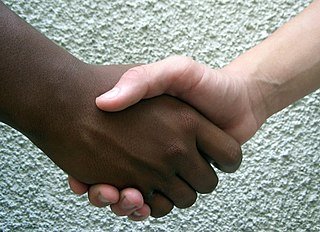
A handshake is a globally widespread, brief greeting or parting tradition in which two people grasp one of each other's hands, and in most cases, it is accompanied by a brief up-and-down movement of the grasped hands. Customs surrounding handshakes are specific to cultures. Different cultures may be more or less likely to shake hands, or there may be different customs about how or when to shake hands.

A hug is a form of endearment, found in virtually all human communities, in which two or more people put their arms around the neck, back, or waist of one another and hold each other closely. If more than two people are involved, it may be referred to as a group hug.

Greeting is an act of communication in which human beings intentionally make their presence known to each other, to show attention to, and to suggest a type of relationship or social status between individuals or groups of people coming in contact with each other. Greetings are sometimes used just prior to a conversation or to greet in passing, such as on a sidewalk or trail. While greeting customs are highly culture- and situation-specific and may change within a culture depending on social status and relationship, they exist in all known human cultures. Greetings can be expressed both audibly and physically, and often involve a combination of the two. This topic excludes military and ceremonial salutes but includes rituals other than gestures. A greeting, or salutation, can also be expressed in written communications, such as letters and emails.

Hand-kissing is a greeting gesture that indicates courtesy, politeness, respect, admiration, affection or even devotion by one person toward another. A hand-kiss is considered a respectful way for a gentleman to greet a lady. Today, non-ritual hand-kissing is rare and takes place mostly within conservative class or diplomatic contexts. Today, the hand kiss has largely been replaced by a kiss on the cheek or a handshake.
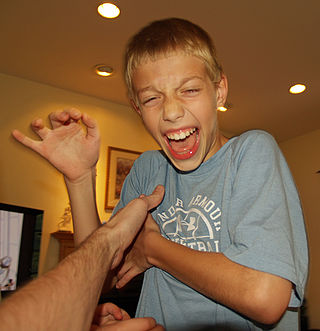
Haptic communication is a branch of nonverbal communication that refers to the ways in which people and animals communicate and interact via the sense of touch. Touch is the most sophisticated and intimate of the five senses. Touch or haptics, from the ancient Greek word haptikos is extremely important for communication; it is vital for survival.

An Eskimo kiss, nose kiss, or nose rub is a gesture of affection where one rubs the tip of one's nose against another person's face. In Inuit culture, the gesture is known as a kunik, and consists of pressing or rubbing the tip of one's nose against another's cheek. In non-Inuit English-speaking culture, two people Eskimo kiss by rubbing the tips of their noses together. Nose-to-cheek kisses are found in other cultures as well.

The holy kiss is an ancient traditional Christian greeting, also called the kiss of peace or kiss of charity, and sometimes the "brother kiss", or the "sister kiss". Such greetings signify a wish and blessing that peace be with the recipient, and besides their spontaneous uses they have certain ritualized or formalized uses long established in Christian liturgy.
Negiah, literally "touch", is the concept in Jewish law (Halakha) that forbids or restricts sensual physical contact with a member of the opposite sex except for one's spouse, outside the niddah period, and certain close relatives to whom one is presumed not to have sexual attraction. A person who abides by this halakha is colloquially described as a shomer negiah.

A secret handshake is a distinct form of handshake or greeting which indicates membership in or loyalty to a club, clique or subculture. The typical secret handshake involves placing one's fingers or thumbs in a particular position, one that will be recognized by fellow members while seeming to be a normal handshake to non-members. This is most frequently associated in the popular consciousness with college fraternities, fraternal orders and secret societies.
A valediction, or complimentary close in American English, is an expression used to say farewell, especially a word or phrase used to end a letter or message, or a speech made at a farewell.

Etiquette in Asia varies from country to country even though certain actions may seem to be common. No article on the rules of etiquette, nor any list of faux pas, can ever be complete. As the perception of behaviors and actions vary, intercultural competence is essential. A lack of knowledge about the customs and expectations of Asian people can make even those with good intentions seem rude, foolish, and disrespectful.
Etiquette in Latin America varies by country and by region within a given country.
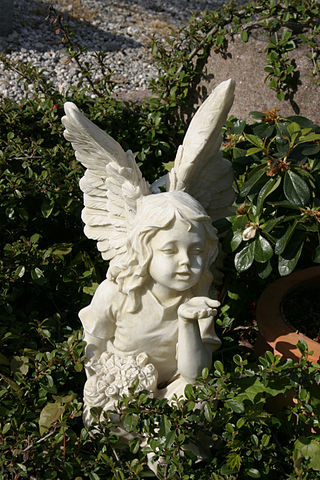
An air kiss, blown kiss, or thrown kiss is a ritual or social gesture whose meaning is basically the same as that of many forms of kissing. The air kiss is a pretence of kissing: the lips are pursed as if kissing, but without actually touching the other person's body. Sometimes, the air kiss includes touching cheek-to-cheek. Also, the gesture may be accompanied by the mwah sound. The onomatopoeic word mwah has entered Webster's dictionary.
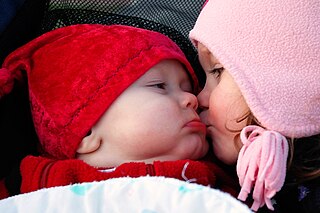
Many societies have traditions which involve kissing. Kissing can indicate joy or be used as part of a greeting. Kissing involves the touching of one's lips to the lips or other body part, such as the cheek, head or hand of another person. Sometimes people often kiss their friends as a way of giving luck or even showing feelings.
In Pakistan, Islamic culture is predominant, but Pakistan also has its own cultural etiquette based mainly on South Asian influences.

Mano is an "honouring-gesture" used in Filipino culture performed as a sign of respect to elders and as a way of requesting a blessing from the elder. Similar to hand-kissing, the person giving the greeting bows towards the hand of the elder and presses their forehead on the elder's hand. Usually performed with the right hand, the person showing respect may ask "Mano po" or "[Pa-]bless po" to the elder in order to ask permission to initiate the gesture. Typically someone may mano to their older relatives upon entry into their home or upon seeing them.

The socialist fraternal kiss was a special form of greeting between socialist state leaders. The act demonstrated the special connection that exists between Communist countries, consisting of an embrace, along with a series of three kisses on alternate cheeks. In rare cases, when the two leaders considered themselves exceptionally close, the kisses were given on the mouth rather than on the cheeks.
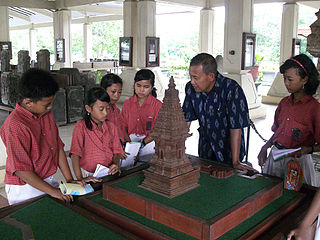
Various codes of etiquette in Indonesia govern the expectations of social behavior in the country and are considered very important. Etiquette demonstrates respect and is a key factor in social interactions. Like many social cultures, etiquette varies greatly depending on one's status relative to the person in question. Some conventions may be region-specific, and thus may not exist in all regions of Indonesia. The following are generally accepted contemporary customs in Indonesia.




















